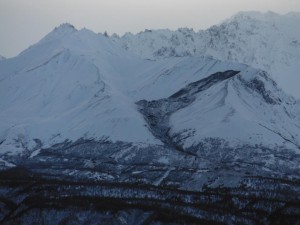
A large landslide has transformed a mountainside near the Matanuska Glacier. Locals noticed the landslide in mid-February. It left a black streak of rock and debris on the unnamed mountain at least a mile long.
Sheep Mountain lodge owner Zack Steer first heard about the landslide when some friends drove by it on the way to his place. The next week, he was heading to Anchorage and took his camera along. The slide is clearly visible if you look south from around mile 94 of the Glenn Highway.
“It just looks like part of the mountain just fell off and slid down. And when you look closely at it, you just realize it was an avalanche of rock debris. And it just conjures this image in your mind of tumbling rock and dirt and soil and trees and basically just a river of earth moving down the hill and makes you really glad you weren’t there in front of it when it happened,” Steer said.
Russell Riddles feels the same way.
“I mean, if you would have been there, you wouldn’t be here anymore,” he said.
Riddles was driving down the Glenn Highway with his wife when he first spotted it. He is a manger at the Long Rifle Lodge nearby. Riddles says there are some informal moose camps in the area, but he thinks they were spared by the slide:
“One of the local kids hiked up there and said the moose camp one of the neighbor guys uses, it went right to the edge of it, actually knocked down the spruce tree that he hangs some of his stuff off of, but did not actually wipe out his little area he goes to every year,” Riddles said.
The landslide is on state land. The Department of Natural Resources knows about the slide, but doesn’t plan to do any work to investigate it further. But landslide expert Marten Geertsema is very interested in learning more about it. Geertsema is a Geomorphologist with the Province of British Columbia in Canada. From pictures, he says the slide looks like a deep, bedrock failure.
“The deeper landslides tend to have delayed responses to environmental conditions,” Geertsema said. “So for example if there was a warm summer that could have an influence, or even a very wet summer, those affects are often delayed in these deep-seated landslides.”
Geertsema says slides can also be the result of fatigue that builds up under a slope over centuries or even millennia. But he says large slides like the one off the Glenn Highway are becoming more common around the world. He says there is evidence the increase may be linked to permafrost melt due to global warming:
“I think warming is especially going to be important in places like Alaska and Canada and in high mountain regions around the world. Obviously if you get wetter conditions, that will contribute as well. Like last year Alaska had a tremendously heavy snow pack and that triggered a number of rock avalanches, in the early snow melt season… Lituya was one of them,” Geertsema said.
The landslide that happened off Lituya Mountain in Glacier Bay National Park last June was the largest one ever recorded in North America. It ran for more than five miles down a wide glacier. Geertsema says no one knows how often big landslides occur in Alaska, but it’s valuable to take note when they happen.
“I think it’s important to document them and its important to figure out what the baselines are and how things are changing. These events do have profound effects on the environment,” she said.
Given the vast wilderness areas in Alaska, Geertsema thinks a lot of large landslides in the state probably go undetected.
Annie Feidt is the broadcast managing editor at Alaska Public Media. Reach her at afeidt@alaskapublic.org. Read more about Annie here.





